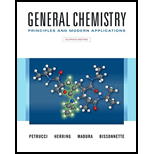
Concept explainers
Interpretation:
Total
Concept introduction:
A complex ion is formed when a metal ion reacts with a Lewis base in solution. This reaction is defined in terms of
The Metal ion which is positively charged functions as a Lewis acid and Lewis base or the ligand has one or more lone pairs of electrons. For example, Cu2+, which is a highly charged and small metal ion having asignificant tendency to function as Lewis acids, consequently exhibiting the highest affinity to form complex ions.
The development of a complexion is a stepwise procedure, and everystep has its equilibrium constant. When two of the equations are added together, the equilibrium constants multiply. The Equilibrium Constant reflects the concentration in a reaction, which is the molarity, written as moles per liter
The products of a reaction are present in the numerator, and the denominator has the reactants. The alphabets in upper-case are the molar concentrations of the reactants and products, and the alphabets in lower-case are the
Want to see the full answer?
Check out a sample textbook solution
Chapter 24 Solutions
Mastering Chemistry With Pearson Etext -- Standalone Access Card -- For General Chemistry: Principles And Modern Applications (11th Edition)
- Use the formation constant of [Au(CN)2] in Appendix K to determine the equilibrium concentration of Au+(aq) in a solution that is 0.0071 M CN and 1.1 104 M [Au(CN)2]. Is it reasonable to conclude that 100% of the gold in solution is present as the [Au(CN)2] complex ion? Explain.arrow_forwardWhat types of isomers are possible for the following compounds or complex ions? (a) K[Co(NH3)2Cl4] (b) Pt(en)Cl2 (square-planar) (c) [Co(NH3)5Cl]2+ (d) [Ru(phen)3]Cl3 (e) Na2[MnCl4] (tetrahedral) (f) [Co(NH3)5NO2)2+arrow_forward
 Chemistry: The Molecular ScienceChemistryISBN:9781285199047Author:John W. Moore, Conrad L. StanitskiPublisher:Cengage Learning
Chemistry: The Molecular ScienceChemistryISBN:9781285199047Author:John W. Moore, Conrad L. StanitskiPublisher:Cengage Learning ChemistryChemistryISBN:9781305957404Author:Steven S. Zumdahl, Susan A. Zumdahl, Donald J. DeCostePublisher:Cengage Learning
ChemistryChemistryISBN:9781305957404Author:Steven S. Zumdahl, Susan A. Zumdahl, Donald J. DeCostePublisher:Cengage Learning Chemistry: An Atoms First ApproachChemistryISBN:9781305079243Author:Steven S. Zumdahl, Susan A. ZumdahlPublisher:Cengage Learning
Chemistry: An Atoms First ApproachChemistryISBN:9781305079243Author:Steven S. Zumdahl, Susan A. ZumdahlPublisher:Cengage Learning
 Chemistry: Principles and ReactionsChemistryISBN:9781305079373Author:William L. Masterton, Cecile N. HurleyPublisher:Cengage Learning
Chemistry: Principles and ReactionsChemistryISBN:9781305079373Author:William L. Masterton, Cecile N. HurleyPublisher:Cengage Learning Chemistry & Chemical ReactivityChemistryISBN:9781337399074Author:John C. Kotz, Paul M. Treichel, John Townsend, David TreichelPublisher:Cengage Learning
Chemistry & Chemical ReactivityChemistryISBN:9781337399074Author:John C. Kotz, Paul M. Treichel, John Townsend, David TreichelPublisher:Cengage Learning





